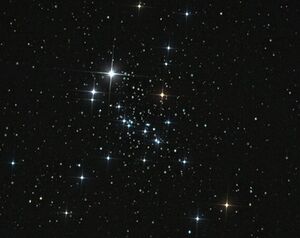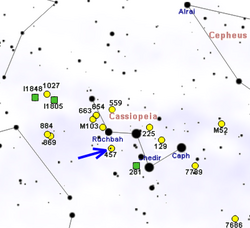Astronomy:NGC 457
| NGC 457 | |
|---|---|
 Open cluster NGC 457 in Cassiopeia | |
| Observation data (J2000.0 epoch) | |
| Constellation | Cassiopeia |
| Right ascension | 01h 19m 32.6s |
| Declination | +58° 17′ 27″ |
| Distance | 7.922 kly (2.429[1] kpc) |
| Apparent magnitude (V) | 6.4 |
| Apparent dimensions (V) | 13.0′ |
| Physical characteristics | |
| Other designations | Owl Cluster, E.T. Cluster, Caldwell 13, Cr 12, Mel 7, OCL 321, Lund 43, H VII-42, h 97, GC 256, |
NGC 457 (also designated Caldwell 13, and known as the Dragonfly Cluster, E.T. Cluster, Owl Cluster, Kachina Doll Cluster or Phi Cassiopeiae Cluster)[2] is an open star cluster in the constellation Cassiopeia.
Discovery
It was discovered by William Herschel on August 18, 1780, with a 6.2 inch reflector telescope, and catalogued as VII 42.[3]
Visibility
It is an easy target for amateur astronomers, and can be seen even with small telescopes in light-polluted skies.
Characteristics
It lies over 7,900 light years away from the Sun. It has an estimated age of 21 million years.[1] The cluster is sometimes referred by amateur astronomers as the Owl Cluster[4] or the E.T. Cluster (due to its resemblance to the movie character). Two bright stars Phi Cassiopeiae (magnitude 5 and spectral type F0) and HD 7902 (magnitude 7) can be imagined as eyes. It is not yet clear if Phi Cassiopeiae is a member of the cluster, and if it is, then it would be one of the brightest stars known, surpassing Rigel in luminosity. For comparison, the Sun at the same distance as Phi Cassiopeiae would shine at just 17.3 magnitude. The next brightest star is the red supergiant variable star V466 Cassiopeiae. The cluster features a rich field of about 150 stars of magnitude 9-13. About 60 stars have been identified as true members of the cluster.
Gallery
References
- ↑ 1.0 1.1 Frinchaboy, Peter M. (2008). "Open Clusters as Galactic Disk Tracers. I. Project Motivation, Cluster Membership, and Bulk Three-Dimensional Kinematics". The Astronomical Journal 136 (1): 118–145. doi:10.1088/0004-6256/136/1/118. Bibcode: 2008AJ....136..118F. See table I, p. 12.
- ↑ "The Dragonfly Cluster (Open Cluster)". https://in-the-sky.org/data/object.php?id=NGC457.
- ↑ "NGC 457, Owl Cluster, E.T. | Deep⋆Sky Corner". https://www.deepskycorner.ch/ngc457/ngc457.en.php.
- ↑ "NGC 457". Astronomy Magazine. http://cs.astronomy.com/asy/m/starclusters/490709.aspx.
External links
- "NGC 457 on SEDS". http://spider.seds.org/ngc/ngc.cgi?ngc457.
- NGC 457 on WikiSky: DSS2, SDSS, GALEX, IRAS, Hydrogen α, X-Ray, Astrophoto, Sky Map, Articles and images
 |



